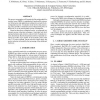Free Online Productivity Tools
i2Speak
i2Symbol
i2OCR
iTex2Img
iWeb2Print
iWeb2Shot
i2Type
iPdf2Split
iPdf2Merge
i2Bopomofo
i2Arabic
i2Style
i2Image
i2PDF
iLatex2Rtf
Sci2ools
89
Voted
FPL
2008
Springer
2008
Springer
Power reduction techniques for Dynamically Reconfigurable Processor Arrays
The power consumption of Dynamically Reconfigurable Processing Array (DRPA) is quantitatively analyzed by using a real chip layout and applications taking into account the reconfiguration power. Evaluation result shows that processing power for PEs is dominant and reconfiguration power is about 20.7% of the total dynamic power consumption. Based on the above evaluation results, we proposed two dynamic power reduction techniques: functional unit-level operand isolation and selective context fetch. Evaluation results demonstrate that the functional unit-level operand isolation can reduce up to 20.8% of the dynamic power with only 2.2% area overhead. On the selective context fetch, the power reduction is limited by the increasing of the additional hardware.
Dynamic Power | FPL 2008 | Functional Unit-level Operand | Hardware | Unit-level Operand Isolation |
Related Content
| Added | 26 Oct 2010 |
| Updated | 26 Oct 2010 |
| Type | Conference |
| Year | 2008 |
| Where | FPL |
| Authors | Takashi Nishimura, Keiichiro Hirai, Yoshiki Saito, Takuro Nakamura, Yohei Hasegawa, Satoshi Tsutsusmi, Vasutan Tunbunheng, Hideharu Amano |
Comments (0)

